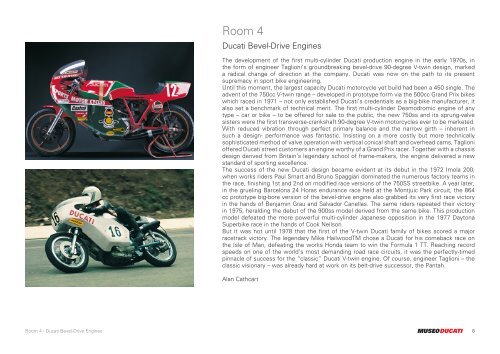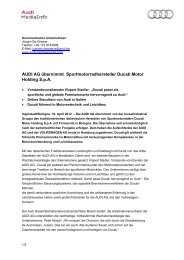Introduction - Ducati
Introduction - Ducati
Introduction - Ducati
You also want an ePaper? Increase the reach of your titles
YUMPU automatically turns print PDFs into web optimized ePapers that Google loves.
Room 4<br />
<strong>Ducati</strong> Bevel-Drive Engines<br />
The development of the first multi-cylinder <strong>Ducati</strong> production engine in the early 1970s, in<br />
the form of engineer Taglioni’s groundbreaking bevel-drive 90-degree V-twin design, marked<br />
a radical change of direction at the company. <strong>Ducati</strong> was now on the path to its present<br />
supremacy in sport bike engineering.<br />
Until this moment, the largest capacity <strong>Ducati</strong> motorcycle yet build had been a 450 single. The<br />
advent of the 750cc V-twin range – developed in prototype form via the 500cc Grand Prix bikes<br />
which raced in 1971 – not only established <strong>Ducati</strong>’s credentials as a big-bike manufacturer, it<br />
also set a benchmark of technical merit. The first multi-cylinder Desmodromic engine of any<br />
type – car or bike – to be offered for sale to the public, the new 750ss and its sprung-valve<br />
sisters were the first transverse-crankshaft 90-degree V-twin motorcycles ever to be marketed.<br />
With reduced vibration through perfect primary balance and the narrow girth – inherent in<br />
such a design- performance was fantastic. Insisting on a more costly but more technically<br />
sophisticated method of valve operation with vertical conical shaft and overhead cams, Taglioni<br />
offered <strong>Ducati</strong> street customers an engine worthy of a Grand Prix racer. Together with a chassis<br />
design derived from Britain’s legendary school of frame-makers, the engine delivered a new<br />
standard of sporting excellence.<br />
The success of the new <strong>Ducati</strong> design became evident at its debut in the 1972 Imola 200,<br />
when works riders Paul Smart and Bruno Spaggiari dominated the numerous factory teams in<br />
the race, finishing 1st and 2nd on modified race versions of the 750SS streetbike. A year later,<br />
in the grueling Barcelona 24 Horas endurance race held at the Montjuic Park circuit, the 864<br />
cc prototype big-bore version of the bevel-drive engine also grabbed its very first race victory<br />
in the hands of Benjamin Grau and Salvador Canellas. The same riders repeated their victory<br />
in 1975, heralding the debut of the 900ss model derived from the same bike. This production<br />
model defeated the more powerful multi-cylinder Japanese opposition in the 1977 Daytona<br />
Superbike race in the hands of Cook Neilson.<br />
But it was not until 1978 that the first of the V-twin <strong>Ducati</strong> family of bikes scored a major<br />
racetrack victory. The legendary Mike HailwoodTM chose a <strong>Ducati</strong> for his comeback race on<br />
the Isle of Man, defeating the works Honda team to win the Formula 1 TT. Reaching record<br />
speeds on one of the world’s most demanding road race circuits, it was the perfectly-timed<br />
pinnacle of success for the “classic” <strong>Ducati</strong> V-twin engine. Of course, engineer Taglioni – the<br />
classic visionary – was already hard at work on its belt-drive successor, the Pantah.<br />
Alan Cathcart<br />
Room 4 - <strong>Ducati</strong> Bevel-Drive Engines<br />
8




